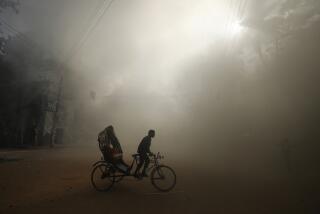Protests grow more violent across Middle East, North Africa
- Share via
Reporting from Sana, Yemen, and New York — A wave of anti-government anger continued to sweep in a crescent from the Mediterranean to the Caspian Sea as tens of thousands of people joined violent, often lethal, protests Thursday against their autocratic Muslim leaders.
Weeks of demonstrations have provoked some presidents and kings to offer concessions and reforms that have often been viewed as too little too late. Others have attempted to smother potential uprisings through force, as in Bahrain, where a government crackdown left at least four protesters dead and more than 200 injured.
In Yemen, thousands of rival demonstrators protesting for and against longtime President Ali Abdullah Saleh clashed in Sana, the capital, amid a sprawl of burning tires, chunks of concrete and fistfights that marked the seventh straight day of unrest across the nation.
Four people were killed in the country’s increasingly violent confrontations.
Thousands of pro- and anti-government protesters faced off on Sana’s Al Rabat Street at midday, throwing stones and pieces of concrete and occasionally rushing each other in mass offensives that one participant likened to 13th century Scottish battles portrayed in the film “Braveheart.”
Young men on both sides of the burning-tire barricade wore Yemeni flags as headbands and capes. Some, seasoned by days of protests, wore helmets and carried cardboard shields. After more than an hour, the police arrived, firing warning shots into the air until the crowds dispersed.
In the port city of Aden, officials at two hospitals said three men died of gunshot wounds after clashes with police, and a local official earlier reported another death by “random gunfire.”
Saleh has made a number of concessions, including agreeing not to run again when his term ends in 2013 or to manufacture his son’s ascent to the presidency. He also promised to begin talks with the opposition coalition about reform and anti-corruption measures within his government.
But Yemenis are concerned that, over the course of his 32-year rule, Saleh has woven such a complex web of allies and family members in key positions in the government and among the tribes that rule Yemen that removing him from power could set off a domino effect, leading to long-term violence in one of the poorest and most volatile countries in the Arab world.
“Yemen is not like Egypt or Tunisia. We have many internal enemies,” said Yasir Refaee, a pro-government protester at a morning rally in front of Sana University. “We need a strong leader like Saleh to face our problems, or we will turn into Somalia.”
But many anti-government protesters said such claims were scare tactics to keep people from protesting.
“They say Yemen will collapse without Saleh, but we don’t believe it. We are done waiting for reforms. We need a new president now. A new parliament, new elections. We will be stronger with real freedom,” said protester Basem Madhehagi, standing amid homemade signs and banners crafted from bedsheets.
Pro-government protesters credited Saleh for bringing peace and unity to Yemen despite an array of internal threats and for making steps toward reform.
But Saleh’s government has been unable to stem rising frustration, especially among the young, over unemployment, poverty and corruption. A third of the Arabian Peninsula state’s people face chronic hunger, and 40% live on less than $2 a day.
Also Thursday, violence erupted in at least five Libyan cities, according state media, witnesses using social networks and independent news sites, although a “Day of Rage” called for in the capital failed to ignite much activity.
“The situation in Tripoli is cautious but quiet,” Libyan journalist Fatthi ben Eissa said. “So far, no demonstrations have taken place in Tripoli apart from the pro-Kadafi protests in the city’s Green Square.”
But in communities elsewhere, clashes between opponents of strongman Moammar Kadafi — Africa’s longest-serving ruler after 41 years in power — and government loyalists backed by security services were widespread and deadly, with 20 people reported killed nationwide.
In the Libyan coastal city of Benghazi, a witness reported that authorities fired on about 5,000 protesters, killing six. The witness added that pro-government thugs were deployed to attack the demonstrators, and numerous journalists were reportedly detained.
To the northeast in Beida, at least 14 people have been killed, including six by security force snipers when 10,000 took to the streets, an opposition website said.
In the city of Zentan, protesters set a police department on fire.
Confirming reports of violence out of Libya is difficult because of the severe restraints the government places on the news media.
In response to the unrest, Kadafi’s government has proposed doubling state employees’ salaries and has released 110 suspected Islamic militants who oppose him — tactics similar to those adopted by other Arab regimes facing recent mass protests. He also has been meeting with tribal leaders to solicit their support.
In Iran, the beleaguered opposition movement is raising the stakes in its confrontation with Tehran’s hard-line Islamist government by calling for another round of protests Sunday.
A statement posted Thursday to the website of former prime minister and 2009 presidential candidate Mir-Hossein Mousavi called on Iranians to take part in memorial services to mark the religiously significant seventh day after the deaths of two protesters killed during opposition rallies Monday.
The magnitude of those protests, which were held in Tehran and other cities, appeared to catch security forces and even demonstrators by surprise. They were the largest public displays against Iran’s authoritarian system since a similarly scattered and violent December 2009 day of unrest that was part of months of protest after the disputed reelection of President Mahmoud Ahmadinejad.
U.S. officials are closely watching the events in Iran, whose nuclear development program worries the West. President Obama and Secretary of State Hillary Rodham Clinton praised the demonstrators and called on Iranian authorities to allow political freedoms.
Iranian lawmakers this week called for the deaths of Mousavi and fellow opposition leader Mehdi Karroubi in response to Monday’s protests. The two supported the rallies in an attempt to build on the demands for change rippling across the Middle East to reignite the so-called green movement, the loosely organized opposition front that sprang from the 2009 election.
Similar to 2009, the current incarnation of the political feud between Iran’s reform-minded moderates and hard-liners is turning into a competition for the streets. Authorities have announced their own rally Friday to express “hatred” for the opposition movement.
Iran’s official media often refer to Mousavi and Karroubi as leaders of the sedition, a religiously loaded accusation of treachery punishable by death under Islamic law. Some authorities are urging fellow hard-liners to remain cautious.
Iranian supreme leader Ayatollah Ali Khamenei originally hailed the uprisings shaking U.S.-backed governments in the Arab world as an “Islamic awakening.” But Iranian authorities are now watching nervously as the demands for change echoing across the region sound within their own borders.
The official rally Friday is likely to be huge. It remains unclear how many will risk turning out for the opposition protests Sunday.
Special correspondent Edwards reported from Sana and Times staff writer Daragahi from New York. Amro Hassan of The Times’ Cairo bureau and Times wire services contributed to this report.
More to Read
Sign up for Essential California
The most important California stories and recommendations in your inbox every morning.
You may occasionally receive promotional content from the Los Angeles Times.













